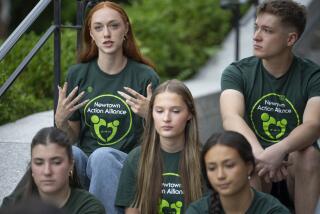Littleton’s Reluctant Experts Try to Help
- Share via
DENVER — However unwilling they are to embrace the title, school officials, teachers and police in Littleton are the world’s reluctant experts on the gruesome topic of school shootings. Since the nation’s worst school massacre nearly two years ago, the town has become one-stop shopping for those seeking to understand teenage violence.
And, as ever, the town stands ready to help. Columbine High officials have contacted their counterparts at Santana High, and the Jefferson County School District has sent the news releases issued after the Columbine attack. At the Jefferson Center for Mental Health, counselors on Tuesday packed up boxes of materials they distributed after the Colorado attack.
“People in that community need to realize that the process of recovery is going to be very, very long, and it’s going to be very, very messy,” said Robin Fudge Finegan, who coordinated counseling for the Jefferson County School District. “People think that the trauma and tragedy ends after the critical incident is over. . . . It’s only just begun.”
There is no timeline for reaction and recovery, but certain things can be expected. If Columbine is any guide, Santee can look forward to the following:
* Teddy bears will pour in from around the world and be added to a makeshift memorial near the school. Well-wishers will don commemorative ribbons and goodwill will embrace the community.
* Task forces and committees and will be formed to probe what went wrong.
* Guilt, recrimination and blame will break out, pitting the community against itself. Backlash will set in.
* Lawsuits will be filed.
“I have yet to see a school shooting situation that has failed to result in school-shooting lawsuits,” said Scott Robinson, a Denver attorney who has tracked the 19 Littleton civil cases.
The first order of business will be to deal with the trauma. In Littleton, people from across the country flooded hotlines with calls; others visited mental health facilities. In the weeks after the killings, crisis calls quadrupled and requests for ongoing mental health services went up 50%.
“At first, there’s a lot of calls,” said Harriet Hall, head of the Jefferson Center for Mental Health. “We were mobbed. Then it goes quiet. We know people are in trouble, but they shift their focus to ‘getting back to normal.’
“Then there’s a secondary hit. We’ve seen some pretty strong reactions on the part of parents that came up a year and a year-and-a-half later. . . . Parents focus on their kids, then it hits them.”
Hall said her biggest concern with troubled adolescents who hear about a shooting tragedy is the possibility of suicide.
When school reconvened after the shooting, Columbine doubled the number of campus security guards to four, installed 16 surveillance cameras, instituted the use of identity cards, and equipped doors with key cards. To soothe jangled nerves, two mental health counselors were added to the staff, bringing the school total to eight. A safe room was established, where distraught teachers or students could retreat for privacy and quiet.
“It goes beyond the physical pieces we put in place,” said Rick Kaufman, a school district spokesman. He said officials also put tip boxes in schools and held seminars for students on hate speech and zero tolerance for bullying and threats.
The school environment is more easily controlled than the community’s. Columbine became a lightning rod for political discussions of gun control, violence in the media, parental liability and rap songs.
“What we know for sure is that there is going to be conflict,” Finegan said. “There’s a honeymoon period and the community begins to say, ‘We are not going to let this tear our community apart.’ People really believe that. It is inevitable there will be conflict. People really need to hear that. The blaming is starting already in Santee.”
More to Read
Sign up for Essential California
The most important California stories and recommendations in your inbox every morning.
You may occasionally receive promotional content from the Los Angeles Times.














